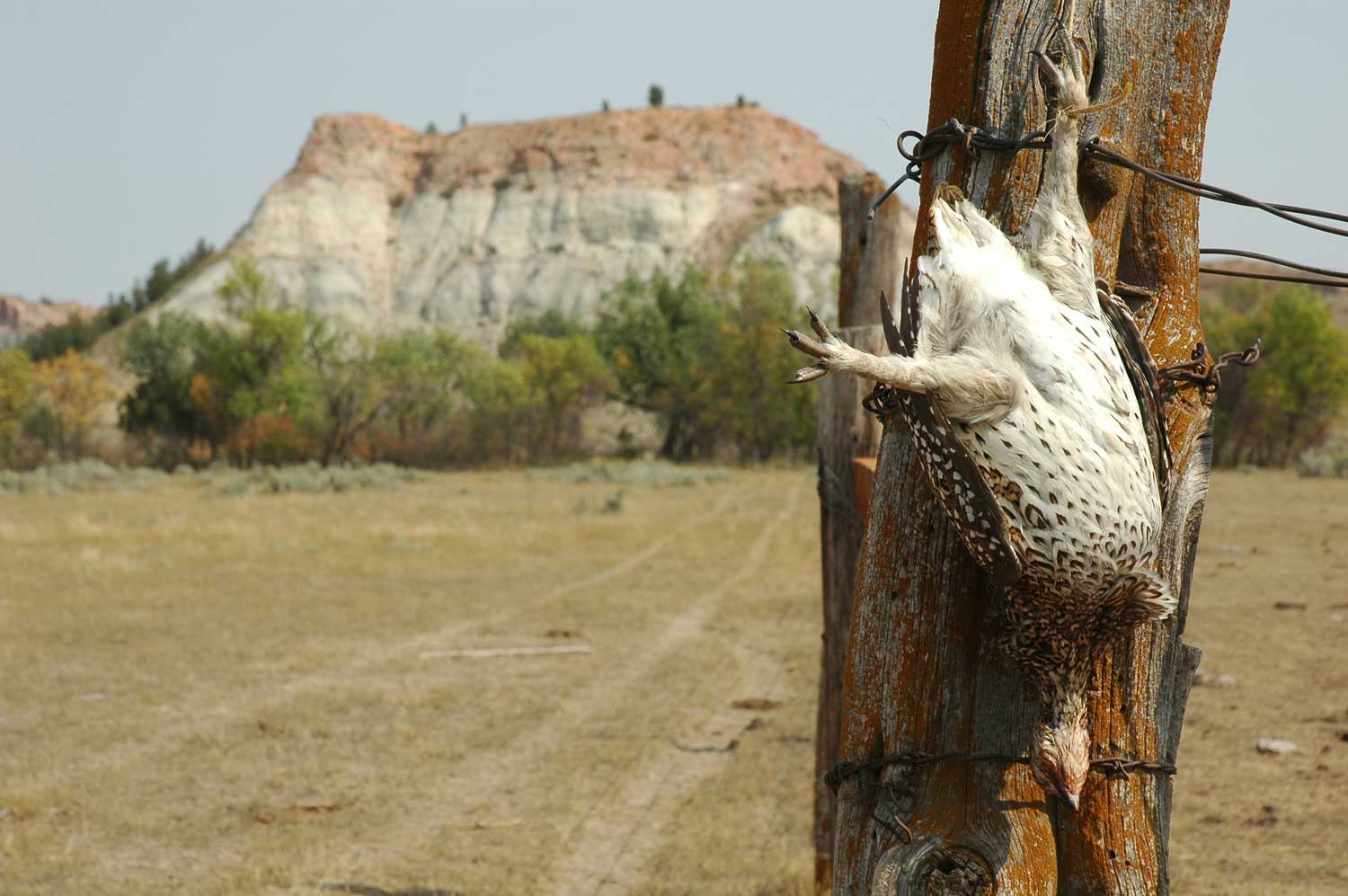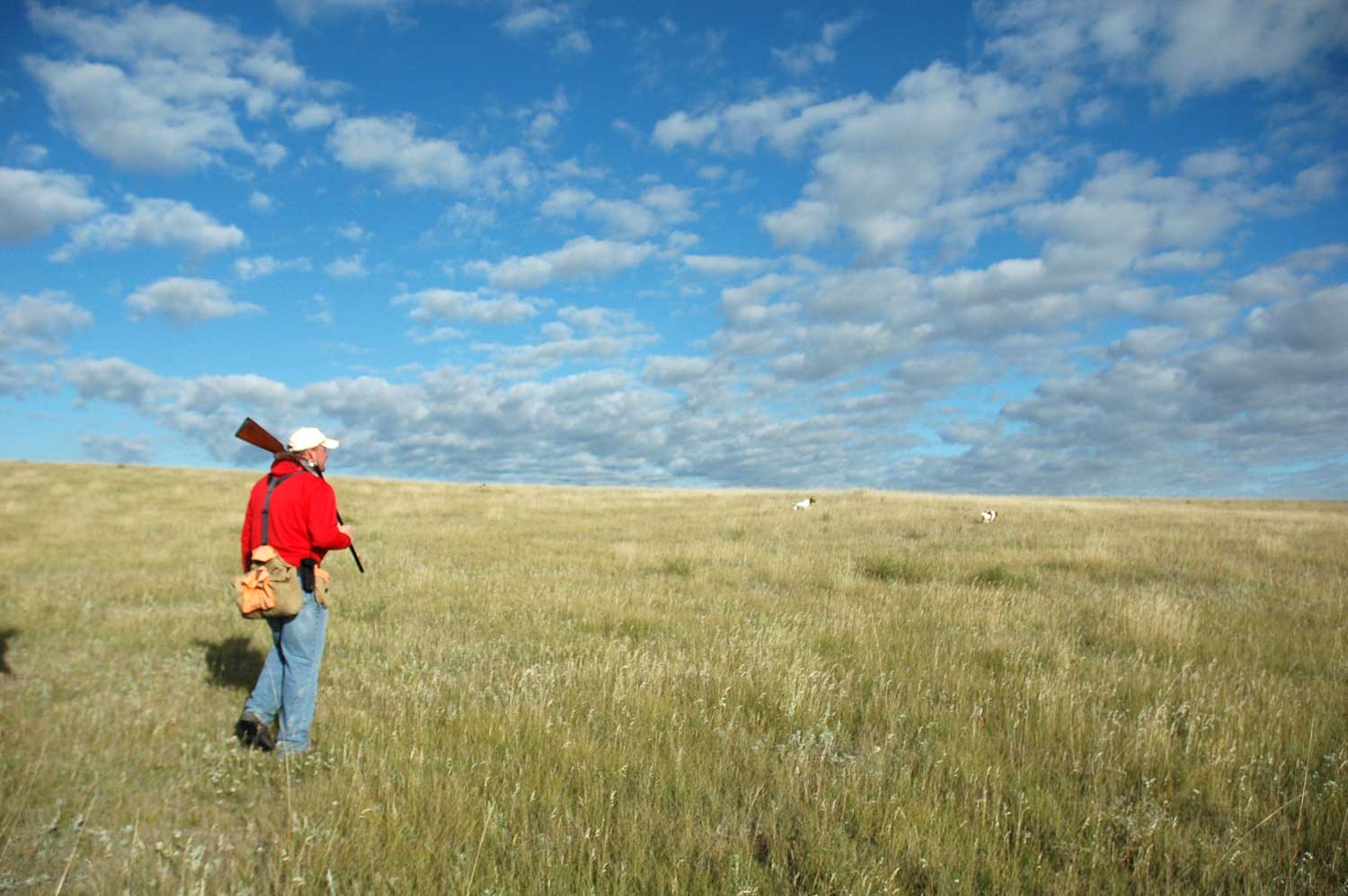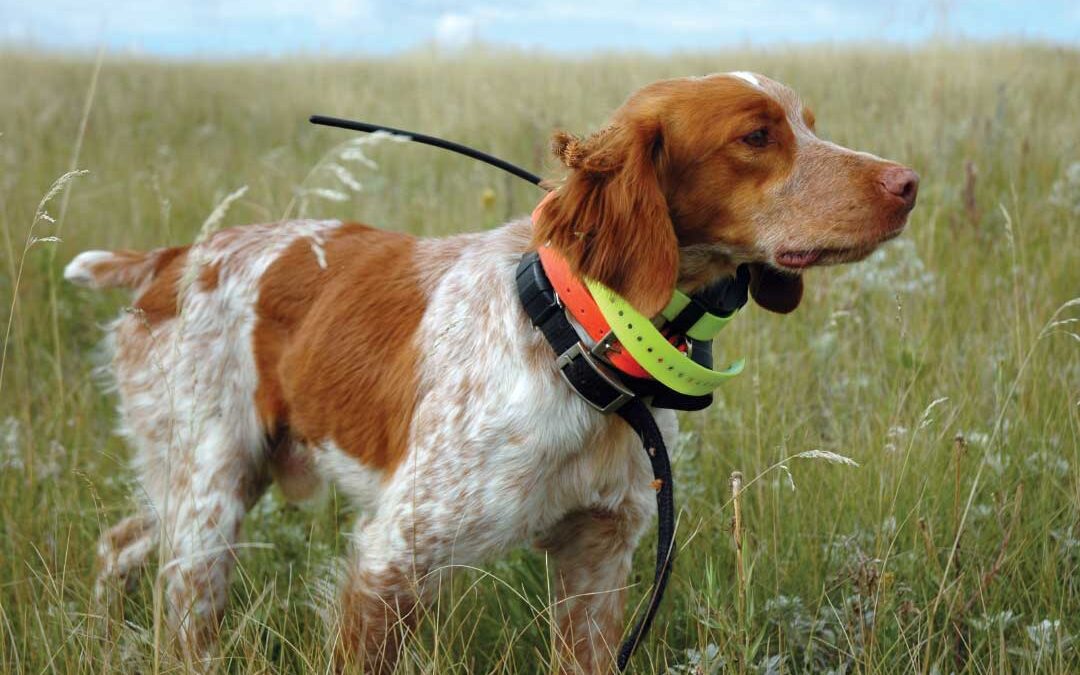It was the kind of heat that has weight—like an enormous hand pressing down. Every so often a puffy cloud would pass, obscuring the sun and providing a few moments of blessed relief. But then the sky would clear, the sun’s unblinking gaze would hammer down once again, and I’d literally stagger under the force of the blow.
They say only mad dogs and Englishmen venture out in the midday sun, but there’s a third category: September prairie grouse hunters.
The good news is that Daphne, the pretty tri-colored setter I had at the time, was holding up remarkably well. She had youth and a light-footed way of going on her side; she’d also taken a dip in every stock dam within striking distance as we ambled across a certain choice section of the Ft. Pierre National Grasslands.
We’d covered a lot of country without moving birds, but it wasn’t for any lack of effort on her part. Finally, working up a vaguely defined cleft towards a low ridge, Daphne whirled and pointed. There was nothing about this spot that appeared any different from a dozen other spots we’d hunted that morning, but that’s the thing about prairie grouse: They’re where you find them.
Or, as my old hunting partner, Steve Nelson, the Sage of Lake Oahe, liked to say, “They gotta be somewhere—but they could be anywhere.”
This particular bunch of birds was precisely where Daphne said they were. They held obligingly, too, letting me cut the distance in half before flushing en masse from the shaggy bluestem. Their darkly barred breasts told me they were prairie chickens and, while there were roughly a dozen targets to choose from, I managed to focus on one and tumble it with the Fox’s right tube. Then, summoning more composure than I normally display, I found another bird, touched off the left barrel, and watched in elation as it cartwheeled as well.
A double on prairie chickens with a shotgun that predates World War I, over a point by a dog you bred, whelped in your basement and raised in your backyard…. If it gets better than that, it almost has to be illegal.
It occurs to me that hunting in September is largely about finding a place where the world isn’t green. Or at least where the green is moderated by a significant infusion of tans, browns and what are collectively referred to as “earth tones.” Locating a landscape with this color combination generally means heading West and, if possible, going high.
I almost said “getting high” but then I remembered that that has another connotation besides gaining elevation.
So we do our homework, load up the dogs and light out for the wide-open spaces. Montana, Idaho, the Dakotas, the Sandhills of Nebraska—places where the country is big, the birds are wild and the rewards are commensurate with the challenges. To succeed, both you and your dogs have to be fit as fiddles and on top of your games. If you’re out of shape or out of sync, you’ll find yourselves skedaddling home with your tails between your legs.
This is the voice of experience speaking. The first time I attempted a do-it-yourself prairie grouse hunt, I lasted less than a day. It didn’t help that I arrived in the Sandhills just as a murderous heat wave was rolling over the Great Plains, but in point of fact the dogs and I were completely overmatched. We weren’t prepared, physically or mentally, for the scale of the landscape, the harshness of the terrain, or the distances you need to cover to give yourself a realistic shot at finding birds.
Hard lessons, as they say. But if you persevere, and learn from your mistakes, and especially if you find a maestro willing to take you under his wing, you can attain some small measure of proficiency. Enough, you hope, to taste success from time-to-time.

One of the first people to open this door for me was the aforementioned Steve Nelson. Singer of songs and teller of tales, Nels seemed to know every landowner in South Dakota west of the Missouri River. It was through Nels that I enjoyed the rare privilege of hunting sharp-tailed grouse on the Hauck Ranch, the vast spread where the action sequences in Dances with Wolves were filmed. (It’s now owned by Ted Turner.) The bison grazing on the grassy hillsides there allowed me to glimpse, however briefly, the prairies as Sitting Bull and Crazy Horse knew them.
At the other end of the spectrum was the scruffy farm, miles down a dirt road in South Dakota’s White River country, where Nels led Andy Cook and me one searingly hot September afternoon. How Nels had found it was a little mysterious, even by the standards of someone who’d made a career out of “grousin’ around,” but Lord, did it have sharptails.
In Montana, I’ve had the great good fortune to hunt on several occasions with the legendary Ben Williams. I’ve had the pleasure of hunting over some of Ben’s most famous dogs, too, the ones you’ve read about in his books: Hershey, Pat, Mike, Mary, Winston (the second one) and my personal favorite, the inimitable Clyde. A jolly, Falstaffian sort, Clyde seemed to embrace his role as the clown prince of Ben’s “pack.”

One day Ben and I were standing on the brow of a hill, watching several of his Brittanies and a pointer or two roll across Big Sky country until they were little more than impressions of movement on a canvas of grass. Maybe 60 yards to our left and a little downslope, Clyde appeared to be watching them, too. We just figured Clyde was being Clyde, letting the youngsters do the heavy lifting while he sagely bided his time, waiting for the right moment to cherry-pick the low-hanging fruit.
No sooner had we taken a couple of steps in his direction, though, when a small covey of Huns hammered out right in front of him. The whole time Ben and I had been standing there, Clyde had been pointing birds!
“That’s Clyde for you,” Ben laughed. “When he points he looks like he’s waiting for a bus.”
A hundred miles or so up the road from Ben’s place in Livingston, another Brittany, name of Rusty, treated Terry Barker and me to a display of bird-finding prowess that still makes me shake my head in disbelief. Long of ear and short of leg, Rusty looked like a slightly overgrown lap dog. If he was carrying a sage hen in his mouth he might—repeat, might—have weighed 30 pounds. But that little guy had a heart, and a motor, out of all proportion to his size.
On that September hunt with his owner, Nolan Huffman—a pretty fair hand with a bird dog, as you might have heard—Rusty found everything. Sharp-tailed grouse, Huns, sage grouse, the occasional out-of-season pheasant: If there was a bird within a quarter mile of us, Rusty pointed it. Eventually the other dogs seemed to figure out that they didn’t stand a chance with Rusty on the ground, and while they didn’t give up, exactly, it was clear from their defeated body language that they were just going through the motions.
I don’t want to say that Rusty made it almost too easy, but on our last afternoon, hunting a beautiful piece of grass in the shadow of the Judith Mountains, I turned to Terry and Nolan and said, “I don’t know about you, but I don’t need to kill any more birds. We’ve already had a great day—and I’m thinking that a beer would taste awfully good.”
At that moment, right on cue, Rusty pointed again. “Tell you what,” Terry said. “We’ll shoot this flush, and then, no matter what happens, we’ll call it a day.”
“No,” I corrected him, “you’ll shoot this flush. I’m done.”
“Suit yourself,” he said, already striding off in Rusty’s direction.
Of course, Rusty had a pair of sharptails pinned, one of which Terry killed to fill his limit. Then, in the same motion with which he’d mounted and fired his 16-gauge Arrieta side-by-side, he brought it down, broke it open, pocketed the empty and the live round, lifted it again, balanced it on his shoulder, and turned toward Nolan and me.
“Did someone say something about beer?”

